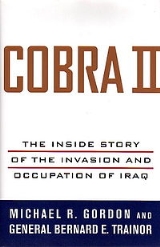
Cobra II
Encyclopedia
Cobra II: The Inside Story of the Invasion and Occupation of Iraq is a 2006 book written by Michael R. Gordon
, chief military correspondent for The New York Times
, and Bernard E. Trainor
, a retired Marine Corps
lieutenant general
, which details the behind-the-scenes decision-making leading to the invasion of Iraq in 2003
. It then follows, in depth, the invasion itself and the early months of the occupation through summer 2003.
Considered comprehensive and even-handed, the book is widely hailed as the pre-eminent source of information on what actually happened and why, and how the Iraqi insurgency
was germinated. The authors had access to a wide range of materials, including many classified documents, and access to the highest levels of the US and Iraqi government and military. They describe in great detail the meetings, correspondence, and positions of the various actors, including not only the US and Iraq, but other countries across the world as they considered the implications of joining the "Coalition of the Willing
".
A large part of the book is dedicated to describing the internal meetings and perspectives of Iraqi leadership, previously unknown to the public. Thus the book covers the war from multiple angles. Predominant among the actors described are the US and Iraqi generals, Defense Secretary Donald Rumsfeld
, and President George W. Bush
and their closest staff members. The book carefully reconstructs the principal battles from primary sources including many interviews with both military leadership and front-line soldiers. Also discussed are the failures of US intelligence and the paucity of planning concerning post-war operations (known as Phase IV).
Michael Gordon (journalist)
Michael R. Gordon is the chief military correspondent for The New York Times.During the first phase of the Iraq war, he was the only newspaper reporter embedded with the allied land command under General Tommy Franks, a position that "granted him unique access to cover the invasion strategy and its...
, chief military correspondent for The New York Times
The New York Times
The New York Times is an American daily newspaper founded and continuously published in New York City since 1851. The New York Times has won 106 Pulitzer Prizes, the most of any news organization...
, and Bernard E. Trainor
Bernard E. Trainor
Bernard E. Trainor is journalist and a retired Marine Corps lieutenant general. He served in the Marine Corps for 39 years in both staff and command capacities. After retiring from the Marine Corps, he began working as the chief military correspondent for the New York Times. He is currently a...
, a retired Marine Corps
United States Marine Corps
The United States Marine Corps is a branch of the United States Armed Forces responsible for providing power projection from the sea, using the mobility of the United States Navy to deliver combined-arms task forces rapidly. It is one of seven uniformed services of the United States...
lieutenant general
Lieutenant General
Lieutenant General is a military rank used in many countries. The rank traces its origins to the Middle Ages where the title of Lieutenant General was held by the second in command on the battlefield, who was normally subordinate to a Captain General....
, which details the behind-the-scenes decision-making leading to the invasion of Iraq in 2003
2003 invasion of Iraq
The 2003 invasion of Iraq , was the start of the conflict known as the Iraq War, or Operation Iraqi Freedom, in which a combined force of troops from the United States, the United Kingdom, Australia and Poland invaded Iraq and toppled the regime of Saddam Hussein in 21 days of major combat operations...
. It then follows, in depth, the invasion itself and the early months of the occupation through summer 2003.
Considered comprehensive and even-handed, the book is widely hailed as the pre-eminent source of information on what actually happened and why, and how the Iraqi insurgency
Iraqi insurgency
The Iraqi Resistance is composed of a diverse mix of militias, foreign fighters, all-Iraqi units or mixtures opposing the United States-led multinational force in Iraq and the post-2003 Iraqi government...
was germinated. The authors had access to a wide range of materials, including many classified documents, and access to the highest levels of the US and Iraqi government and military. They describe in great detail the meetings, correspondence, and positions of the various actors, including not only the US and Iraq, but other countries across the world as they considered the implications of joining the "Coalition of the Willing
Coalition of the willing
The term coalition of the willing is a post-1990 political phrase used to collectively describe participants in military or military-humanitarian interventions for which the United Nations Security Council cannot agree to mount a full UN peacekeeping operation...
".
A large part of the book is dedicated to describing the internal meetings and perspectives of Iraqi leadership, previously unknown to the public. Thus the book covers the war from multiple angles. Predominant among the actors described are the US and Iraqi generals, Defense Secretary Donald Rumsfeld
Donald Rumsfeld
Donald Henry Rumsfeld is an American politician and businessman. Rumsfeld served as the 13th Secretary of Defense from 1975 to 1977 under President Gerald Ford, and as the 21st Secretary of Defense from 2001 to 2006 under President George W. Bush. He is both the youngest and the oldest person to...
, and President George W. Bush
George W. Bush
George Walker Bush is an American politician who served as the 43rd President of the United States, from 2001 to 2009. Before that, he was the 46th Governor of Texas, having served from 1995 to 2000....
and their closest staff members. The book carefully reconstructs the principal battles from primary sources including many interviews with both military leadership and front-line soldiers. Also discussed are the failures of US intelligence and the paucity of planning concerning post-war operations (known as Phase IV).

